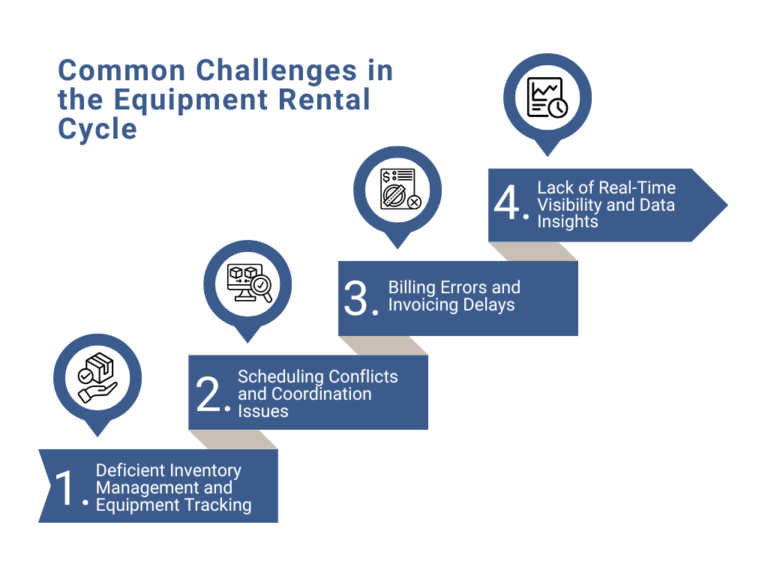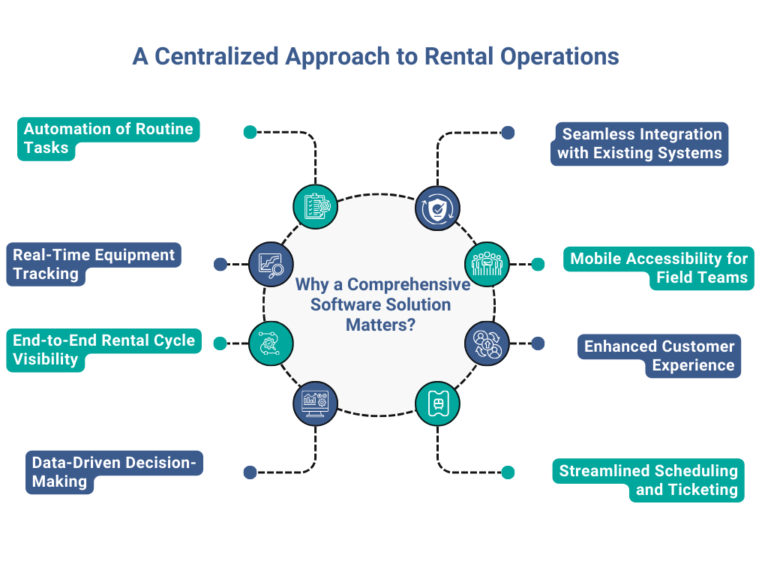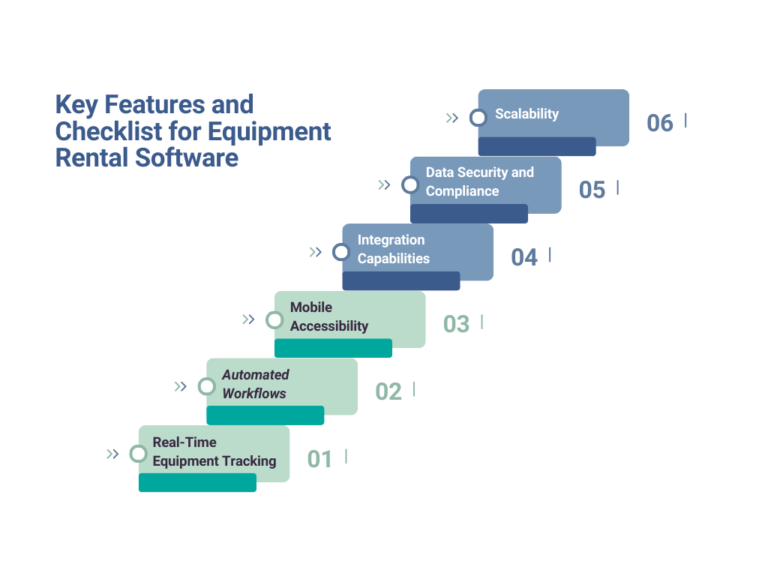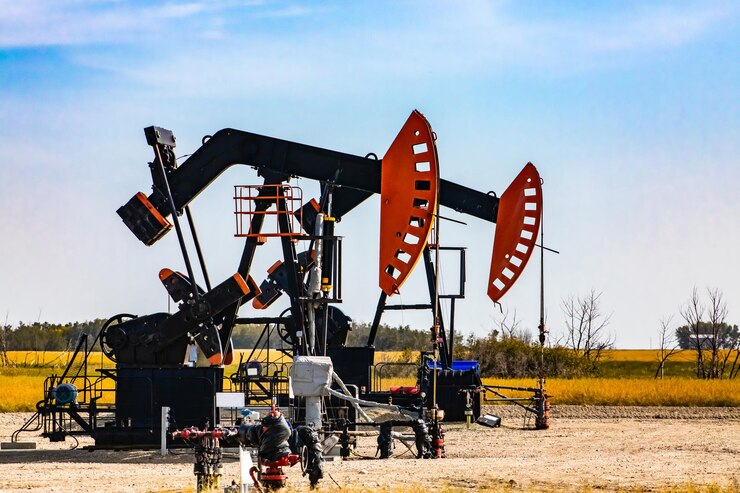In oilfield equipment rental, disconnected processes kill both productivity and profits.
Rental companies face increasing demands to manage complex logistics, equipment tracking, and invoicing with precision, all while delivering outstanding customer experiences. Yet, many struggle with fragmented systems that lead to inefficiencies, heavy administrative workloads, and challenges in maintaining visibility across assets.
Let’s explore the common challenges rental companies face and why a comprehensive software platform offers a highly advantageous solution for addressing inefficiencies and improving overall productivity.
Managing equipment rental operations can be complex, with each stage of the rental cycle posing its own unique challenges. From inventory issues to scheduling conflicts, these obstacles can lead to inefficiencies, lost revenue, and customer dissatisfaction.
Here’s a closer look at some of the most common challenges in the equipment rental cycle, highlighting why a streamlined, unified approach is essential.

Keeping track of rental equipment availability, location, and condition can be difficult, especially when using manual processes or disconnected systems.
Using inefficient systems often leads to overbooked or underutilized equipment. A common scenario involves sending rental equipment to the wrong location or having it double-booked. This results in delayed projects and lost time and requires additional expenses to rectify the issue.
Having worked with a range of companies, we’ve observed that inventory mismanagement costs companies an average of 15-20% in lost revenue. This is due to equipment downtime and booking errors. Poor tracking can also cause delays in maintenance, leading to equipment breakdowns at critical times.
Efficiently scheduling deliveries, pickups, and maintenance tasks requires accurate information and timely communication.
When equipment rental companies manage schedules manually, they often experience communication gaps between dispatchers, drivers, field teams, and customers. These lead to missed delivery windows, service interruptions, or overlapping bookings, which can be costly and damaging to customer satisfaction and the company’s reputation.
McKinsey states that AI-driven scheduling can alleviate traditional scheduling challenges, thus leading to improved productivity and reduced downtime. They note that “AI-driven schedule optimizers can alleviate age-old scheduling headaches—reducing employee downtime, improving productivity, and minimizing schedule-related service disruptions.”
Accurate billing can be complicated, especially when rental durations change, equipment usage varies, or additional charges arise.
Manually managing these factors can lead to various issues. If an incorrect invoice is sent out due to missed equipment usage logs or miscalculated rental durations, it can result in disputes, delays, and additional administrative time to resolve the issue.
In the absence of real-time data, decision-makers lack a clear view of equipment status, maintenance needs, and overall asset utilization. A company may miss early signs of equipment wear, leading to unexpected breakdowns. This not only disrupts project timelines but also increases repair costs that could have been prevented with timely maintenance.
We’ve observed that a lack of visibility can reduce asset utilization rates by as much as 25%. A lack of real-time insights prevents data-driven decisions, which results in higher maintenance costs and underused assets.
The cumulative effect of these challenges emphasizes the need for a comprehensive software platform that can centralize inventory tracking, automate scheduling, streamline billing, and provide real-time data insights.
By addressing these common pain points, equipment rental companies can reduce operational inefficiencies, improve customer satisfaction, and ultimately increase profitability.
The equipment rental cycle includes several distinct phases, each of which requires efficient coordination to maximize productivity and minimize costs.
The equipment rental cycle starts with the job setup phase. It is where the creation of contracts, assignment of equipment, and scheduling of necessary resources happens. During this phase, the rental provider collaborates closely with the customer to define rental durations, terms, pricing, and specific customer requirements, setting the foundation for the rental agreement.
However, job setup often suffers from inefficiencies, especially when processes rely on manual contract management.
These inefficiencies in job setup frequently result in scheduling conflicts, inaccurate contract terms, and delays in starting rentals. Ultimately, these issues impact customer satisfaction, strain operational timelines, and can lead to revenue loss for rental businesses.
The equipment delivery and commissioning phase ensures that rented equipment reaches the customer’s site on time, fully functional, and ready for immediate use.
During this phase, the rental team coordinates logistics for equipment delivery and performs necessary pre-delivery inspections. It also uses tracking tools to monitor the equipment’s journey to confirm that it arrives at the correct location as scheduled.
However, this stage often presents several operational challenges.
When delivery and commissioning processes are ineffective, rental providers face increased transportation costs due to rescheduling, delays in project timelines, and potentially dissatisfied customers.
Late or malfunctioning equipment not only disrupts the customer’s operations but also affects the provider’s reputation for reliability and quality. Therefore, efficient management of this phase is essential for successful rental operations.
Effectively tracking equipment usage and managing maintenance during rental periods is vital if you aim to keep assets in top working condition. Proactive monitoring reduces downtime, ensures peak performance, and ultimately strengthens customer satisfaction.
For maintenance teams, this typically involves tracking key data points—usage hours, wear and tear, and scheduling routine services based on real-time equipment needs. Challenges to this process often include:
Without real-time tracking and proactive maintenance, asset utilization rates drop, ROI on equipment decreases, and operational costs rise due to emergency repairs and extended downtimes.
For equipment rental companies, these inefficiencies don’t just affect profitability. They impact customer trust, as clients depend on reliable, well-maintained equipment to keep projects on track.
By adopting a proactive, real-time tracking and maintenance strategy, equipment rental providers can minimize downtime, and reduce costs. Thus, they deliver consistent, high-quality service to clients, fostering stronger, more reliable customer relationships.
At the close of the rental period—or even during—equipment rental companies generate invoices based on factors such as rental duration, usage data, and any additional fees for late returns or repairs. This phase also involves tracking payments, managing accounts receivable, and maintaining consistent revenue streams to support financial stability.
Efficient and timely invoicing is critical for healthy cash flow and a stable financial foundation, but several challenges can arise:
With an automated invoicing and payment collection system, equipment rental companies can enhance cash flow, minimize administrative tasks, and build stronger customer relationships.
An automated approach also improves billing accuracy, accelerates payment timelines, and strengthens profitability. This supports sustainable growth and customer satisfaction.
In the final stage of the rental cycle, equipment is returned, inspected, and prepared for its next rental. This process includes verifying the returned equipment, conducting thorough post-rental inspections to check it for wear or damage, and documenting any necessary repairs or maintenance.
Efficient handling of this phase is essential to ensure that assets are quickly redeployed and ready for future rentals. Unfortunately, equipment rental businesses are prone to experiencing a range of challenges:
For customers, delays in equipment availability can lead to project disruptions, eroding trust and customer satisfaction. A streamlined, standardized approach to equipment return and decommissioning helps equipment rental companies improve operational efficiency, maintain equipment quality, and ensure timely availability for new rentals. This can enhance the overall customer experience and optimize revenue potential.
A comprehensive software platform centralizes equipment rental operations into one integrated system. It offers a more efficient alternative to juggling separate tools for various functions. Here’s how it brings tangible benefits:

Automating scheduling, dispatching, invoicing, and payment collection within a single platform streamlines administrative processes and reduces the friction of managing separate systems. This approach cuts down on repetitive manual tasks, freeing up team members to focus on high-value activities like customer service and strategic planning. Ultimately, it drives more efficient operations and superior client experiences.
Unlike using separate tracking tools, real-time equipment tracking within an all-in-one software platform provides immediate insights into equipment location, condition, and availability. This integration reduces the risk of overbookings, scheduling conflicts, and missed maintenance, ensuring equipment is always ready and in optimal condition. As a result, companies experience minimized downtime and maximized asset utilization.
A centralized view of the entire rental cycle—from job setup to invoicing and decommissioning—enables fast identification and resolution of issues, optimizes processes, and reduces delays. Relying on multiple tools often results in data silos, which complicate visibility and slow decision-making. With a centralized system, teams can proactively manage operations, enhancing both customer satisfaction and operational efficiency.
An end-to-end software solution collects and organizes operational data into a single source of truth, eliminating the challenges of fragmented data from multiple systems. Decision-makers can access accurate, comprehensive metrics on asset utilization, maintenance needs, and financial performance, empowering them to make informed choices, anticipate challenges, and effectively plan for growth.
A centralized rental management platform that integrates with ERP and CRM platforms supports smooth data flow across departments. This eliminates duplicate data entry and minimizes the risk of errors that come with using disconnected tools. With seamless integration, companies save time and reduce the complexity of managing data across various systems.
With a mobile-friendly platform, field teams have on-the-go access to schedules, equipment status, and maintenance logs—all within a single system. Separate tools often require multiple logins and manual data entry, but a comprehensive software platform ensures up-to-date records and faster response times to any issues, enhancing field efficiency and service quality.
A centralized platform enables rental companies to offer a more responsive, reliable experience. Real-time updates, accurate scheduling, and proactive maintenance reduce disruptions for clients. Unlike fragmented systems, an integrated software platform ensures that customer service teams can respond quickly, improving satisfaction and strengthening client relationships.
Managing scheduling and ticketing in a central hub ensures that all active service requests, equipment reservations, and maintenance tickets are visible. This reduces communication gaps and operational delays. Separate systems can lead to missed appointments and fragmented workflows, whereas an integrate software solution ensures timely service responses and simplifies task management for enhanced operational efficiency.
By consolidating functions within a centralized digital platform, equipment rental companies achieve greater control, accuracy, and efficiency compared to using separate tools. This approach not only simplifies rental management but also enhances customer satisfaction and strengthens the competitive edge in an industry where operational excellence and client relationships are critical.
Adopting a centralized digital platform gives equipment rental companies better control, accuracy, and efficiency. This approach not only simplifies rental management but also enhances customer satisfaction, providing a competitive edge in an industry where operational excellence and strong client relationships drive success.
Selecting the right equipment rental software can be a game-changer for your business. It can help you cut costs, streamline operations, enhance asset management, and drive customer satisfaction. This guide provides essential insights and a practical checklist to help you make an informed choice.
When evaluating software options, prioritize solutions with these core features to support efficient, scalable, and secure operations:

Real-time tracking offers continuous visibility into equipment location, status, and availability. This feature ensures your field teams can track equipment status at all times. Thus, it minimizes scheduling conflicts, reduces downtime, and helps maximize asset utilization.
Look for automation in critical workflows such as scheduling, dispatching, invoicing, and maintenance management. Automating these repetitive tasks reduces administrative workload and allows your team to focus on higher-value activities. In return, you can expect higher productivity and reduced risk of human error.
Mobile access empowers field teams to view schedules, log maintenance actions, and update equipment status directly from the field. It also helps keep all information up to date and improve response times. This feature is key to keeping teams connected and operations running smoothly, even when employees are on the go.
Choose a platform that integrates seamlessly with your existing ERP, CRM, and accounting systems. This ensures smooth data flow across departments, reduces duplicate data entry, eliminates silos, and enables your team to access accurate information in real time.
Robust security is essential to protect sensitive information and financial transactions. Look for software with encryption, access controls, and compliance with relevant industry regulations. Prioritizing security strengthens trust with your customers and safeguards your data.
As your business grows, your software should be able to scale with it. Look for solutions that can expand to handle a growing inventory and customer base without a loss in performance.
Investing in equipment rental software with these core features not only simplifies day-to-day management but also positions your business for long-term success. A robust software platform provides the flexibility, visibility, and security needed to deliver exceptional service and optimize your asset performance.
With this guide, FieldEquip aims to empower you with the knowledge and insights to make a well-informed software selection. By following these best practices, you’ll be equipped to choose a solution that enhances your operations, drives customer satisfaction, and supports business growth.
As technology continues to evolve, equipment rental companies must stay ahead of emerging trends to remain competitive and maximize operational efficiency. FieldEquip is committed to future-proofing rental operations, and in this guide, we explore key trends and technologies shaping the future of the industry.
Monitor critical metrics such as engine hours, fuel levels, and temperature, allows rental companies to predict and address potential issues before they lead to costly breakdowns.
According to our observations, predictive maintenance can reduce equipment downtime by up to 30% and maintenance costs by 25%, making it a game-changer for rental businesses focused on efficiency, safety, and reliability.
As field operations become more mobile-centric, rental companies increasingly rely on mobile solutions to manage teams and equipment remotely. Mobile-first management allows field technicians and managers to access job details, equipment status, and service records on the go, reducing response times and enhancing collaboration.
With mobile capabilities, companies can quickly adjust schedules, track real-time updates, and respond promptly to customer needs, improving overall service quality and operational agility.
With more data available than ever, equipment rental companies are leveraging analytics to make smarter, data-driven decisions. By tracking metrics such as equipment utilization, maintenance history, and financial performance, businesses gain valuable insights that support optimized inventory management, predictive maintenance, and resource planning and allocation.
Data-driven decision-making is increasingly essential, especially as companies strive to make proactive adjustments that improve efficiency, reduce costs, and boost customer satisfaction.
Environmental concerns are shaping the equipment rental industry, too, as they push companies toward more sustainable operations. Implementing energy-efficient equipment, reducing fuel consumption, and optimizing route planning are ways rental companies are meeting sustainability goals.
This trend aligns with customer expectations, as eco-conscious clients increasingly prefer providers with environmentally responsible practices.
By adopting these advanced technologies and trends, rental companies can achieve:

FieldEquip is committed to driving the digital transformation of the equipment rental industry. By harnessing the power of mobile-first solutions and data analytics, FieldEquip provides a comprehensive field service management platform that equips rental businesses to thrive in an evolving landscape.
Our solutions help companies leverage industry-leading trends, ensuring they remain competitive, efficient, and ready for the future.
Would you like to leverage industry-leading trends, ensuring they remain competitive, efficient, and ready for the future? Schedule a FieldEquip demo to learn how you can stay ahead.
Would you like to have a free demo or have any questions about FieldEquip?
US Corporate Headquarters 1011 S. Hwy. 6, Suite 117 Houston Texas 77077 US